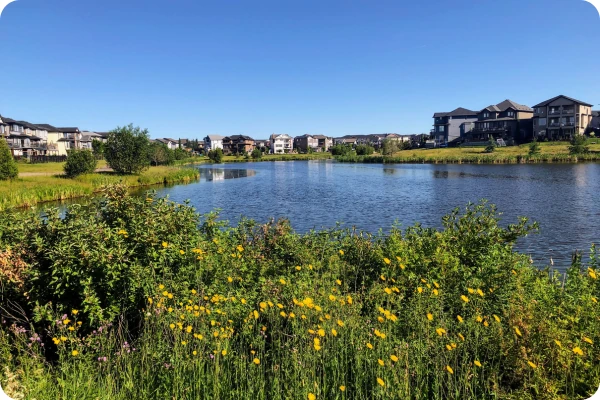At first glance, retention ponds may appear to be just decorative water features, but they are crucial for managing stormwater runoff and protecting communities from floods and erosion. If you’ve ever wondered how deep a retention pond should be or what factors contribute to its depth, you’ll find the answers here.
Ready to discuss your retention pond maintenance needs? Call iSTORMWATER at (410) 231-3455.

What Are Retention Ponds?
Retention ponds, also known as wet ponds or stormwater management ponds, are permanent water bodies designed to collect and store stormwater runoff. These ponds help control flooding, improve water quality, and reduce the impact of pollutants before water reenters natural waterways.
Commonly found near commercial properties, industrial sites, residential developments, and highways, retention ponds play a crucial role in stormwater management. Proper maintenance, including sediment removal and vegetation control, ensures they remain effective in preventing flooding and erosion.
Retention Ponds vs. Detention Ponds
While their names are similar, retention and detention ponds serve different purposes.
- Retention ponds hold water permanently, allowing excess runoff to gradually filter through the ground or exit through controlled drainage. Since they always contain water, they also support aquatic life and can enhance landscape aesthetics.
- Detention ponds remain dry most of the time and only fill with water during heavy rainfall. Their purpose is to slow the flow of stormwater before it is discharged into drainage systems or waterways.
Both pond types help meet stormwater regulations and reduce environmental impact, but retention ponds offer added benefits like water quality improvement and erosion control.
Factors That Determine Retention Pond Depth
Retention pond depth depends on several factors, including:
- Stormwater Volume: The primary factor in determining pond depth is the volume of runoff it must accommodate. Areas with high rainfall or large impervious surfaces (such as parking lots and roads) require deeper ponds.
- Regulatory Requirements: Local and federal stormwater regulations often dictate minimum depth and storage capacity to ensure compliance with environmental standards.
- Soil Composition: The type of soil in the area affects water retention and infiltration rates. Clay-heavy soils retain more water, while sandy soils drain faster, influencing pond depth.
- Slope and Bank Stabilization: To prevent erosion and maintain structural integrity, retention ponds typically have sloped banks with a 3:1 ratio, meaning a 3-foot horizontal extension for every 1-foot vertical drop.
- Aquatic Ecosystem Needs: Some retention ponds are designed to support fish, aquatic plants, and wildlife, requiring deeper sections to maintain ecological balance.
Average Retention Pond Depth
Retention ponds generally range between 3 and 6 feet deep, but larger ponds can be as deep as 30 feet. The depth varies depending on the size of the watershed it serves, expected runoff levels, and engineering specifications.
By comparison, detention ponds typically have depths ranging from 3 to 12 feet since they are designed for temporary water storage rather than continuous water retention.
Why Proper Retention Pond Maintenance Matters
Neglected retention ponds can lead to excessive sediment buildup, decreased storage capacity, and increased flood risks. Regular maintenance tasks such as sediment removal, vegetation management, and erosion control help keep retention ponds functional and compliant with stormwater management regulations.
Schedule Retention Pond Maintenance With iSTORMWATER
If you’re looking for a reliable stormwater management partner, look no further than iSTORMWATER. With over 20 years of industry experience, we provide comprehensive retention pond maintenance services, including inspections, dredging, and vegetation control, across Maryland, Virginia, Washington, DC, and Delaware.
Our certified engineers and project staff are committed to quality and attention to detail, ensuring long-lasting results that meet your needs. We offer upfront inspections, clear communication, and post-job follow-ups to guarantee your complete satisfaction. To help minimize business disruptions, we make it easy to schedule services when it’s most convenient for you.
Trust iSTORMWATER for all your retention pond management needs. Call us at (410) 231-3455 today to request services or schedule an inspection!
Real Results
iStormwater LLC was an excellent choice. They made the process of the Stormwater pond repairs seamless. They took charge of the project and got the project approved and passing the inspection. We highly recommend them and would use them again.
Incredible stormwater management service. The owner John consulted on a property I manage and ended up saving us thousands of dollars in environmental fees from the government. Now, our property is compliant with the EPA and we have a great partner to keep us maintained on stormwater regulations over time.
So helpful with all of my water issues.
Great communication and leadership and a family friendly atmosphere. Thank you John!
Homeowners Associations (HOAs) across the Mid-Atlantic region - from Maryland and Virginia to DC and Delaware - face growing responsibilities when it comes to stormwater...
- Annapolis
- Anne Arundel County
- Baltimore County
- Baltimore
- Bel Air South
- Bethesda
- Bowie
- Cecil County
- Charles County
- Columbia
- Gaithersburg
- Glen Burnie
- Howard County
- Montgomery County
- Pasadena
- Prince George’s County
- Rockville
- Severna Park
- St. Mary’s County



